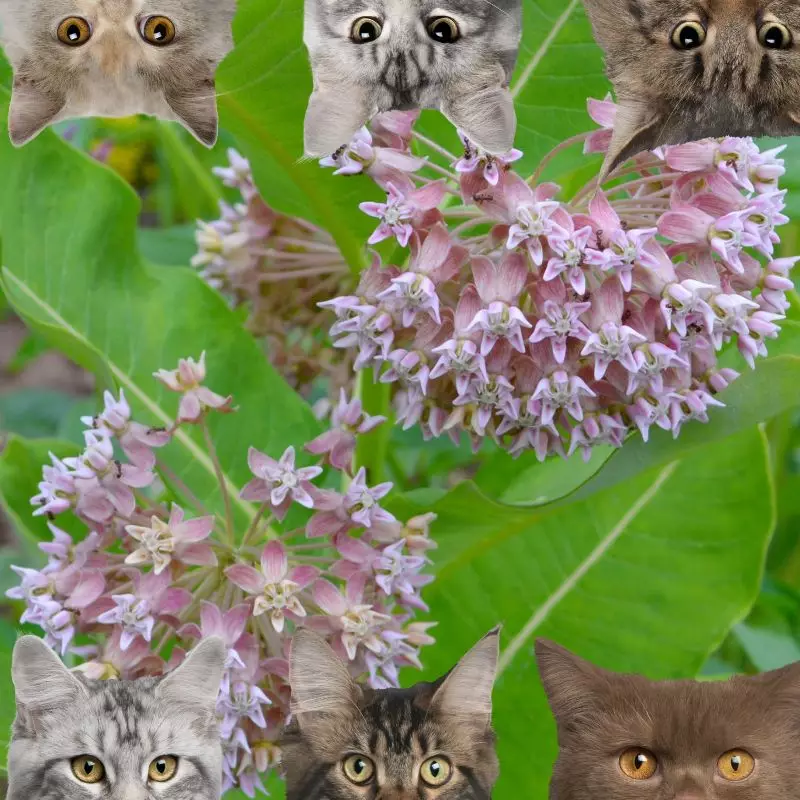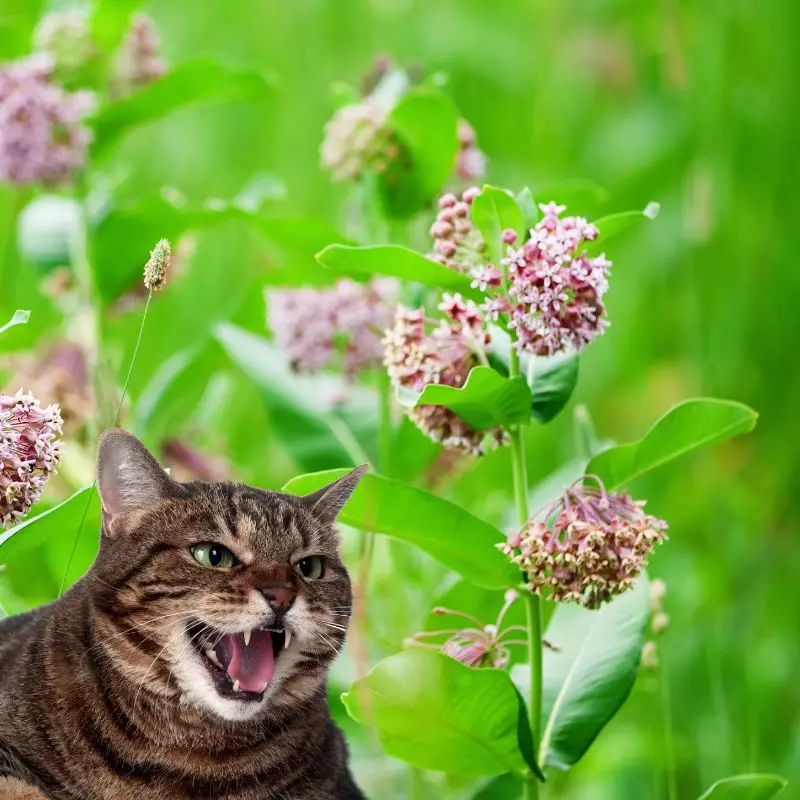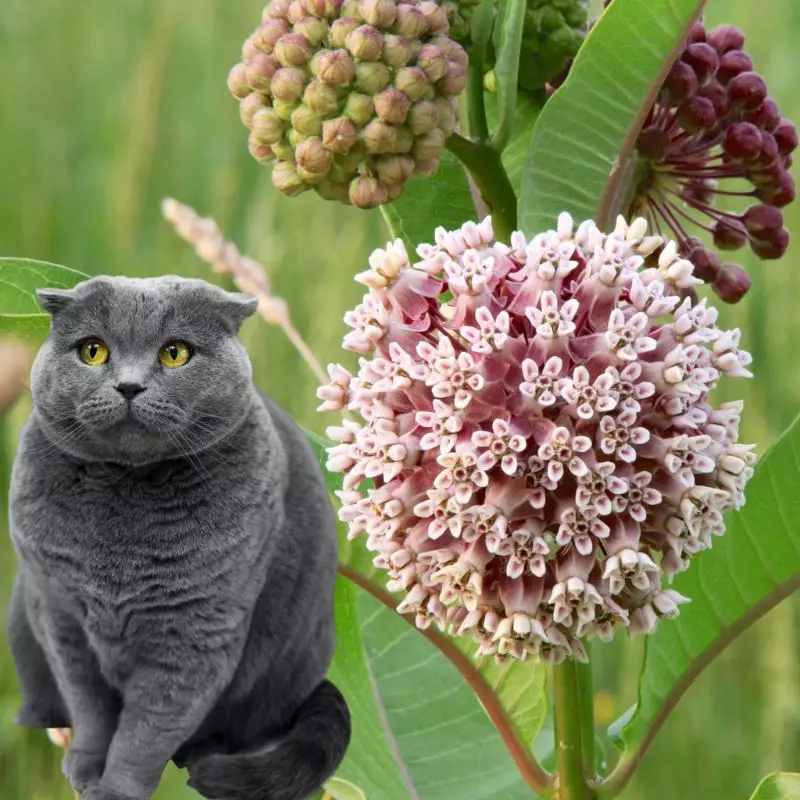This article is written in collaboration with a team of experienced DVMs (doctors of veterinary medicine). With their invaluable insights, we provide accurate and up-to-date information on the potential risks associated with plants, particularly milkweed, and its effects on cats. Additionally, we have referred to high-authority sources such as the ASPCA and PetMD for comprehensive information on every plant.
Milkweed, commonly found in both dry and wet open areas with ample sun exposure, contains toxic elements harmful to cats. Some species possess cardiotoxins, while others are laden with neurotoxins. It’s crucial to note that all parts of the plant, whether dry or fresh, are extremely poisonous. Hazardous and lethal consumption levels are almost identical, with the milky sap within the plant exhibiting the highest concentrations of these toxins.
Galitoxin, a prevalent resinous compound in milkweed, has been linked to symptoms like weakness, spasms, and convulsions common in cases of milkweed poisoning. Additionally, milkweed houses cardiac glycosides that produce symptoms akin to digitalis poisoning, often resulting in, or contributing to, fatalities. These glycosides disturb the heart’s electrolyte balance, causing arrhythmias and potentially leading to cardiac failure. Broad-leaved species primarily showcase cardiotoxic and gastrointestinal effects, while narrow-leaved variants tend to be more neurotoxic.
Clinical Signs of Milkweed Poisoning in Cats

Exposure to milkweed, whether through contact, inhalation, or ingestion, can result in a variety of clinical signs in cats. Understanding each symptom and its underlying cause can assist in recognizing milkweed poisoning early on and seeking prompt veterinary intervention.
- Vomiting: This is a direct response of the digestive system attempting to expel the toxic components ingested.
- Diarrhea: Caused by the body’s attempt to quickly remove toxins from the digestive system.
- Abdominal pain: Inflammation and irritation in the gastrointestinal tract due to the toxins result in discomfort and pain.
- Appetite loss: Discomfort and a feeling of nausea can deter the cat from consuming food.
- Depression: The neurotoxins present can influence the cat’s mood and energy levels.
- Weakness: A general symptom that may arise from the body’s systemic response to the toxins, affecting muscle strength and energy.
- Staggered gait: Neurotoxins affect the cat’s nervous system, leading to unsteady movements and lack of coordination.
- Difficulty breathing: Respiratory distress can occur when toxins impact the respiratory muscles and system.
- Dilated pupils: A sign of neurological disturbance, possibly due to the neurotoxins.
- Bloating: Accumulation of gas in the digestive tract can result from the body’s adverse reaction to the toxins.
- Cardiac abnormalities: Cardiac glycosides in milkweed can disturb the heart’s rhythm, leading to palpitations or arrhythmias.
- Loss of muscular control: This symptom arises due to neurotoxins interfering with nerve and muscle function.
- Hyperthermia: Elevated body temperature can result from seizures or an overactive response to toxins.
- Seizures: Extreme neurological disruption can lead to uncontrollable muscle contractions and spasms.
- Respiratory paralysis: Severe cases can see the respiratory muscles being impacted to a point of paralysis, making it difficult for the cat to breathe.
- Multi-organ failure: Prolonged exposure or ingestion of large quantities can lead to systemic failure of multiple organs due to the widespread effects of the toxins.
- Coma: A deep state of unconsciousness can occur due to extensive neurological or systemic damage.
- Death: In extreme cases, the combined effect of all the toxins can be fatal if not treated promptly.
Early veterinary intervention is crucial to counteract these symptoms and prevent their progression to more severe stages. If a cat displays any of these signs after suspected contact with milkweed, immediate veterinary care is essential.
First Aid and Treatment of Milkweed Poisoning in Cats

Because there is no specific antidote for milkweed intake, the veterinarian’s treatment approach will be symptomatic and supportive. This may involve flushing your cat’s mouth with water if it still has remaining plant matter. Vomiting may be triggered if the cat has recently consumed the plant. Activated charcoal may be also given to your cat or the vet may also perform gastric lavage or stomach pumping to remove and prevent further absorption of toxins from its stomach.
It may be required to deliver medications such as potassium chloride, procainamide, lidocaine, dipotassium EDTA, or atropine sulfate if the cat is showing signs of cardiac irregularities. Lidocaine is frequently used as an antiarrhythmic. Monitoring kidney function is also critical, the vet will keep a constant eye on heart activity for arrhythmias.
Recovery from Milkweed Poisoning in Cats

In general, the prognosis for animals who have consumed a substantial amount and not identified right away is poor to grave. The outlook can range from favorable to guarded for animals that have consumed a tiny to moderate dose, or in circumstances where the ingestion was recognized early and treatment was offered.
Prevention of Milkweed Poisoning in Cats
Cats who frequently wander around outdoors have higher chances of exposure to milkweed. Thus, keeping your cat safe indoors is the best method to prevent milkweed poisoning. Keep your cat in good health condition and stimulated at home to reduce the possibility of your cat straying away far from home.
If you love plants but have cats at home, check out these lists:





